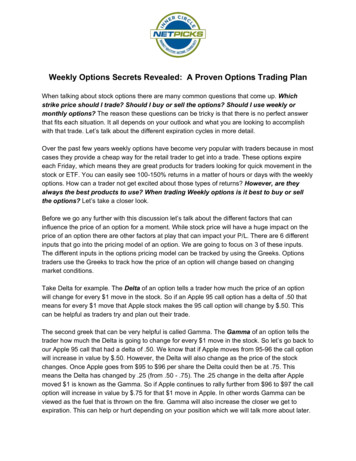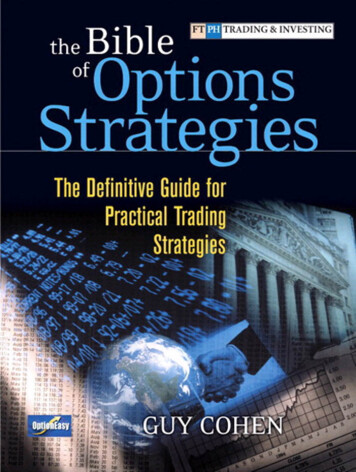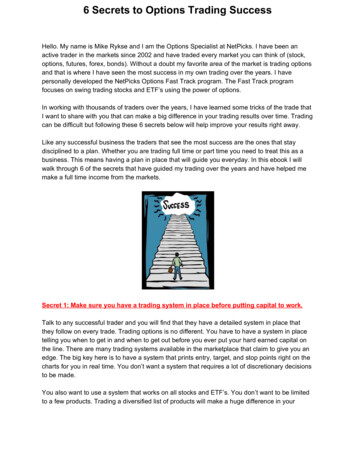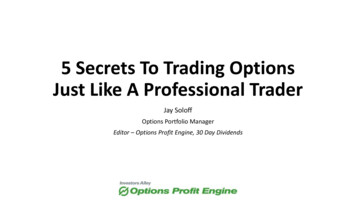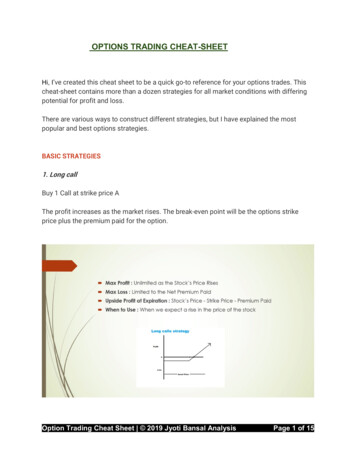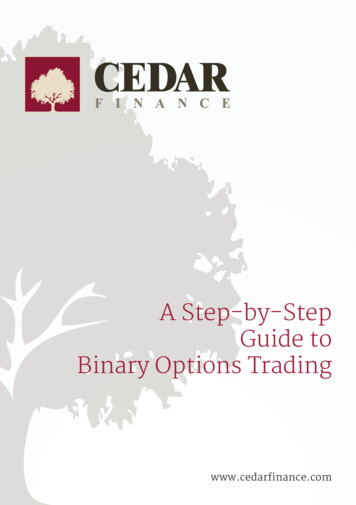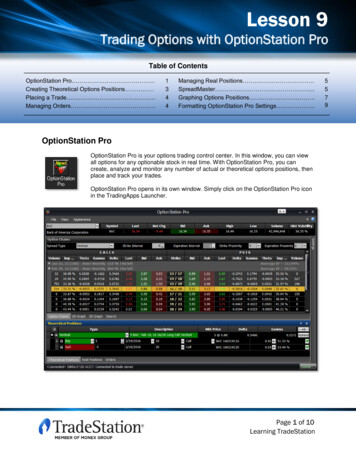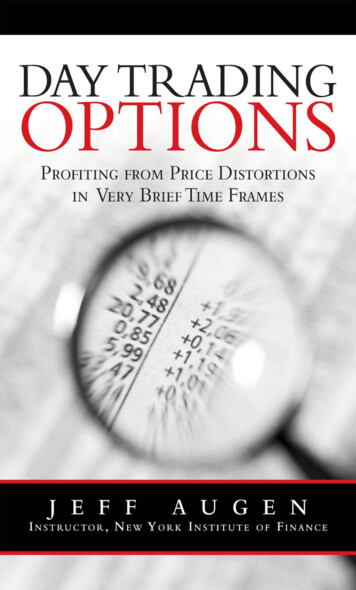
Transcription
DAYTRADINGOPTIONS
This page intentionally left blank
DAYTRADINGOPTIONSProfiting from Price Distortionsin Very Brief Time FramesJeff Augen
Vice President, Publisher: Tim MooreAssociate Publisher and Director of Marketing: Amy NeidlingerExecutive Editor: Jim BoydEditorial Assistant: Myesha GrahamOperations Manager: Gina KanouseSenior Marketing Manager: Julie PhiferPublicity Manager: Laura CzajaAssistant Marketing Manager: Megan ColvinCover Designer: Chuti PrasertsithManaging Editor: Kristy HartProject Editor: Betsy HarrisCopy Editor: Cheri ClarkProofreader: Kathy RuizSenior Indexer: Cheryl LenserSenior Compositor: Gloria SchurickManufacturing Buyer: Dan Uhrig 2010 by Pearson Education, Inc.Publishing as FT PressUpper Saddle River, New Jersey 07458This book is sold with the understanding that neither the author nor the publisher is engaged inrendering legal, accounting, or other professional services or advice by publishing this book.Each individual situation is unique. Thus, if legal or financial advice or other expert assistanceis required in a specific situation, the services of a competent professional should be sought toensure that the situation has been evaluated carefully and appropriately. The author and thepublisher disclaim any liability, loss, or risk resulting directly or indirectly, from the use orapplication of any of the contents of this book.FT Press offers excellent discounts on this book when ordered in quantity for bulk purchases orspecial sales. For more information, please contact U.S. Corporate and Government Sales, 1800-382-3419, corpsales@pearsontechgroup.com. For sales outside the U.S., please contactInternational Sales at international@pearson.com.Company and product names mentioned herein are the trademarks or registered trademarks oftheir respective owners.All rights reserved. No part of this book may be reproduced, in any form or by any means,without permission in writing from the publisher.Printed in the United States of AmericaThird Printing: December 2011ISBN-10: 0-13-702903-9ISBN-13: 978-0-13-702903-7Pearson Education LTD.Pearson Education Australia PTY, LimitedPearson Education Singapore, Pte. Ltd.Pearson Education North Asia, Ltd.Pearson Education Canada, Ltd.Pearson Educatión de Mexico, S.A. de C.V.Pearson Education—JapanPearson Education Malaysia, Pte. Ltd.Library of Congress Cataloging-in-Publication DataAugen, Jeffrey.Day trading options : profiting from price distortions in very brief time frames / Jeff Augen.p. cm.ISBN-13: 978-0-13-702903-7 (hardback : alk. paper)ISBN-10: 0-13-702903-91. Options (Finance)—United States. 2. Options (Finance) 3. Day trading (Securities) 4.Stock price forecasting. 5. Investment analysis. I. Title.HG6024.A3A9217 2010332.64—dc222009025835
On April 12, 1938, six thousand people crowdedinto Grand Central Station to watch RichardWhitney, former President of the New York StockExchange, being escorted off to Sing Sing prisonby armed guards On June 29, 2009, applause rang out in aManhattan courtroom as former NASDAQChairman, Bernard Madoff, was sentenced to 150years in prison for engineering the largestPonzi scheme in history This book is dedicated to the thousands of peoplewho, over the years, have lost all their money toinvestment frauds. Serious investing is bothcomplex and time consuming. There are noshortcuts—including letting others invest for you.
This page intentionally left blank
ContentsPreface.xiiiChapter 1: Basic Concepts .1The Case for Short-Term Trading .1Recent Changes in the Options Market SupportDay Trading .8Unstable Markets Provide Unique Advantagesto Option Traders .10Technical Analysis, Technical Indicators,and Price Distortions.26Endnotes .33Chapter 2: New Directions in AutomatedTrading .35Key Concepts.35High-Performance Computing and MarketEfficiency.36A Simple Illustration .42Testing the Market’s Efficiency .45Fooled by Randomness .67Insider Trading .73Summary .76Further Reading.78Endnotes .79
viiiDay Trading OptionsChapter 3: Trading Volatility Distortions .81Key Concepts.81Introduction—The Implied Volatility Surface .82Calculating Fair Volatility .88Parsing Price Changes by Weekday .99Trading Volatility Distortions .106Alternate Trade Structures—Backspreads .117Volatility and Price Spike Distribution.127Summary .128Endnotes .129Chapter 4: Working with Intraday PriceSpike Charts .131Key Concepts.131Introduction—A New Charting Tool.132Basic Calculations .134Price Spikes at the Single-Minute Level .142Examples of Ultra-Short-Term VolatilitySwings .147Summary .156Chapter 5: Special Events .157Key Concepts.157Introduction .158Unavoidable Volatility Distortions.160Event Trading .163Summary .167Endnotes .168Index .169
AcknowledgmentsI’d like to thank the team that helped pull the booktogether. First and foremost is Jim Boyd who provided the opportunity and was willing to publish anew topic with an unusual focus.Writing is easy. Making charts and tables is alsoeasy. Creating a publication-quality book, however, is adifferent matter. Once again it has been my pleasure towork with Betsy Harris who was responsible for creating a final edited production document. In that regard Iwould also like to thank Cheri Clark who read everyword and found many subtle and important mistakes.Finally, I would like to acknowledge the excellentwork of the Pearson marketing team and especiallyJulie Phifer and Laura Czaja who always seem willingto put real thought behind new book concepts.Writing this book has been a real privilege because itallowed me to focus on controversial topics during avery unique time in financial history. Working with ateam of focused professionals made the project possible.
This page intentionally left blank
About the Authoreff Augen, currently a private investor and writer,has spent more than a decade building a uniqueintellectual property portfolio of databases,algorithms, and associated software for technicalanalysis of derivatives prices. His work, which includesmore than a million lines of computer code, isparticularly focused on the identification of subtleanomalies and price distortions.Augen has a 25-year history in informationtechnology. As a cofounding executive of IBM’s LifeSciences Computing business, he defined a growthstrategy that resulted in 1.2 billion of new revenueand managed a large portfolio of venture capitalinvestments. From 2002 to 2005, Augen was Presidentand CEO of TurboWorx Inc., a technical computingsoftware company founded by the chairman of theDepartment of Computer Science at Yale University. Hisbooks include Trading Options at Expiration, TheOption Trader’s Workbook, and The Volatility Edge inOptions Trading. He currently teaches option tradingclasses at the New York Institute of Finance.J
This page intentionally left blank
PrefaceIt is only fitting and proper that I write these wordswith a 1929 Conklin fountain pen—a gift from mywife. Most writers prefer a computer. I suppose thatmakes sense since it’s where the words ultimately endup as a string of ones and zeros, but for me it’s theConklin. This pen has seen it all: the crash of ‘29, thegreat depression, World War II, Korea and Vietnam, thefirst Gulf War, another crash in 1987, Long TermCapital, 9/11 and the recession and war that followed,NASDAQ boom, NASDAQ bust, and most recently,the 2008–2009 banking crisis. I have a high level ofrespect for this old pen, and I’m always amazed at howsmoothly it glides across the page as it undoubtedly did80 years ago. Maybe there’s a message in that effortlessglide. Maybe some things never change.Everyone knows that the market crashed in 1929.Back in those days, the private investor didn’t havemuch of a chance. Big time stock manipulators droveprices into the stratosphere by selling to each other.When the price climbed high enough that the averageinvestor finally jumped in, they dumped their stock, collected the profit, and watched the collapse. As always,the little guy took the hit because he was playing a gamethat he didn’t understand.Eighty years later, the game remains remarkablyunchanged. The recent crash serves as a terrific illustration. Investment banks built high-risk portfolios ofmortgage-backed derivatives, money poured in, bonusesxiii
xivDay Trading Optionsflowed like water, and when it all collapsed the generalpublic picked up the tab. Smart investors who saw thecollapse coming and shorted the market lost money asthe bubble inflated. Those who stayed in the marketwatched their money evaporate when the bubble burst.But many private investors—including the author of thisbook—did just fine. For the most part, they tended to bestudents of both the economy and the financial markets—active traders armed with a trading platform,charting software, and access to live news feeds.These investors often believe that they can level theplaying field by working hard and staying one stepahead of the market with a combination of the latestsoftware and news sources. They often follow a combination of fundamental and technical indicators thatinclude analyst statements, earnings reports, companynews, insider transactions, short interest, and a few different types of price charts. Unfortunately, even thesmartest and most diligent traders are further back inthe pack than they might think. That is because thepack includes corporate insiders with much better information and institutional investors/analysts with directaccess to the companies they invest in. Consider, forexample, IBM—a heavily traded blue chip stock followed closely by many analysts and a large investmentcommunity. Between January 2008 and the end of May2009 when these words were written, the average transaction price for IBM stock was 103.21. However, IBMinsiders whose trades are publicly disclosed realized anaverage price of 122.65 in the open market—a 19%improvement.1The difference is surprising because insiders arerestricted with regard to when they can sell stock; in this
Prefacexvsense they are disadvantaged and might be expectedto realize a lower average selling price. Lifting allrestrictions, therefore, might cause the gap to wideneven further.In either case the point is clear. A private investorwith some charting software and a few analyst reportsis no match for corporate insiders who know considerably more about their own company than the generalpublic. The same private investor must also lose to largeinstitutional analysts who have access to the companiesthey write about. Analysts routinely visit these companies and meet with key executives before writing theirreports. Furthermore, their reports are proprietary andare often made available to a restricted group of subscribers or large clients of a particular brokerage. Theplaying field cannot be level when all investors do nothave access to the same information.Many investors who realize that they are operatingat an information disadvantage avoid strategies thatdepend on fundamental business analysis and, instead,focus on purely technical approaches. Today’s tradingplatforms accommodate this thinking with very sophisticated analytical tools. Dozens of technical indicatorsare available in addition to scripting languages thatallow investors to create and test their own. Most platforms also allow automatic order entry based on a predefined set of rules. Serious traders can chartinformation in a variety of time frames and simultaneously analyze this information with different indicators.When a signal appears, their software can instantlyplace a trade without asking for confirmation. It wouldseem that such systems might have the potential to levelthe playing field for the private investor.
xviDay Trading OptionsUnfortunately, the capability gap between institutional and private investors is even larger on the technical side than it is on the fundamental side; thatdifference is growing rapidly. During the past few years,computerized algorithmic trading systems have becomethe dominant force in most financial markets, and theirsophistication exceeds anything available to the generalpublic. Technical traders must now compete with supercomputers that process millions of data items each second and make investment decisions at the individual“tick” level.
Day trading options : profiting from price distortions in very brief time frames / Jeff Augen. p. cm. ISBN-13: 978-0-13-702903-7 (hardback : alk. paper) ISBN-10: 0-13-702903-9 1. Options (Finance)—United States. 2. Options (Finance) 3. Day trading (Securities) 4. Stock price forecasting. 5. Investment analysis. I. Title. HG6024.A3A9217 2010 332.64—dc22 2009025835. On April 12, 1938, six .
